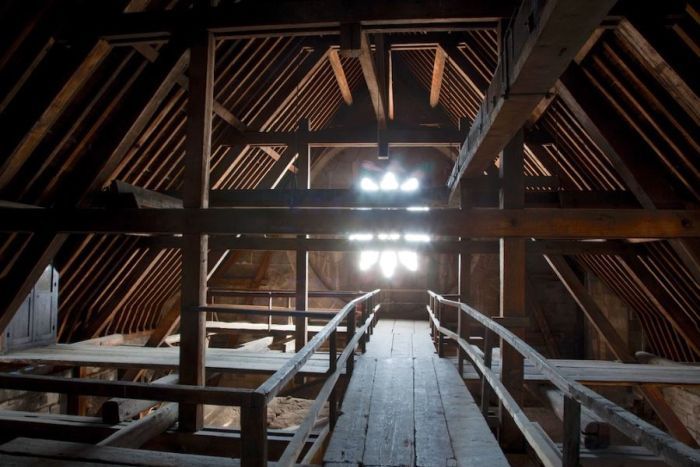Notre Dame cathedral 3D tour — from above and within, how fire hit the heart of Paris
Updated
See what was lost when this cultural cornerstone went up in flames, and what is now left to build upon as Paris takes stock after the Notre Dame fire.
At 6:20pm on Monday, a fire alarm sounded in France's most popular tourist attraction.
Twenty-three minutes later, the heart of Paris was aflame.
 Photo:
Smoke billows as fire engulfs the spire of Notre Dame Cathedral in Paris, France April 15, 2019. (Reuters: Benoit Tessier)
Photo:
Smoke billows as fire engulfs the spire of Notre Dame Cathedral in Paris, France April 15, 2019. (Reuters: Benoit Tessier)
Investigators say the blaze started in the attic.
Known affectionately as the "forest", it was made of 1,300 interlocked wooden beams, each crafted from an individual tree planted as early as the 8th or 9th century.
It did not have sprinklers or firewalls installed, like a modern building might. "There had been a systematic refusal to install anything electrical" because of the risk of fire, Pierre Housieaux, president of the Paris Historical Association, told the New York Times.
From the attic, the fire spread through the roof toward the spire. Google Earth imagery shows the challenge firefighters faced when trying to tackle the blaze.
The spire was originally built in the 13th century but was removed in 1786, after hundreds of years of damage from wind.
The version that burned on Monday — a 750-tonne oak structure with a lead exterior — was added in the 19th century.
It took just minutes to collapse.
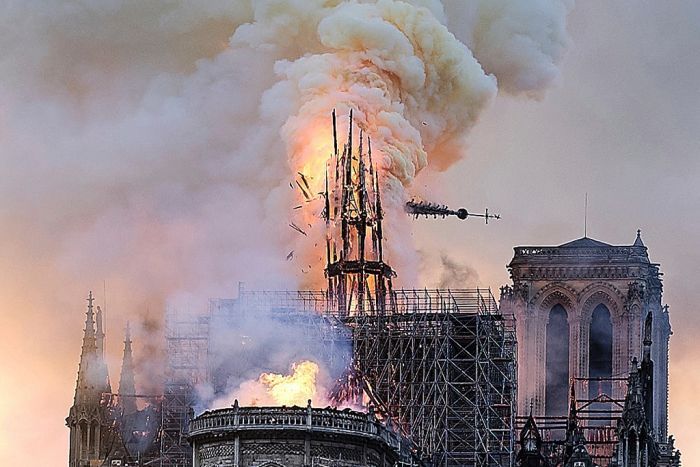 Photo:
Timber within the cathedral's support structure caught fire, leading to the collapse of the roof. (AP: Diana Ayanna)
Photo:
Timber within the cathedral's support structure caught fire, leading to the collapse of the roof. (AP: Diana Ayanna)
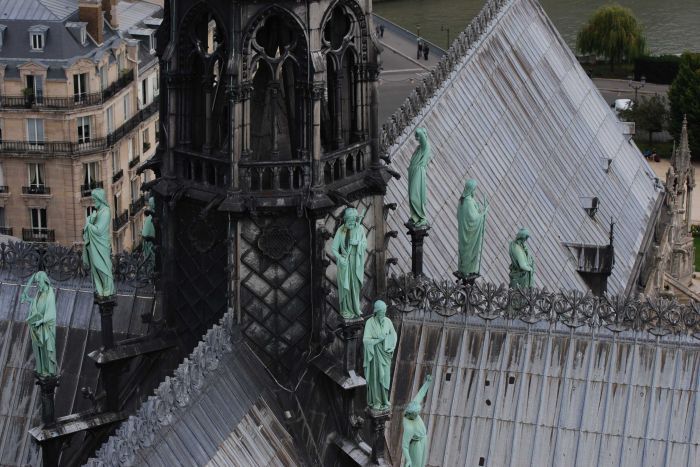 Photo:
The apostle statues on the roof and spire of Notre Dame cathedral in Paris. (Wikipedia: Tammy Lo)
Photo:
The apostle statues on the roof and spire of Notre Dame cathedral in Paris. (Wikipedia: Tammy Lo)
Some of the sculptures of the 12 Apostles, which run down the footings of the spire, were saved — removed just days before the fire because of the renovations.
But the exterior is covered with art. Countless grotesques and gargoyles — ornate characters used as much for dispersing rain water as for decoration — as well as the building's renowned stained-glass windows were all at risk from the flames.
The three largest rose windows measure up to 19 metres in diameter. Notre Dame's heritage director Laurent Prades said they were not destroyed but may have been damaged by the heat.
 Photo:
Notre Dame's rose windows date back to the 13th century. (Wikimedia Commons: Krzysztof Mizera)
Photo:
Notre Dame's rose windows date back to the 13th century. (Wikimedia Commons: Krzysztof Mizera)
The flames spread towards the cathedral's two iconic towers — for a long time the tallest structures in Paris — and at one point, as the fire burned, it seemed like the entire cathedral might perish.
Notre Dame has been at the centre of history for almost a millennium, from Joan of Arc to the Nazi occupation — yet now the end seemed near, watched in real-time by millions around the world.
It could have left a smouldering ruin on a site that is the literal heart of Paris, the place where all distances are measured from. Instead the towers were saved by firefighters, about 500 of whom battled the blaze.
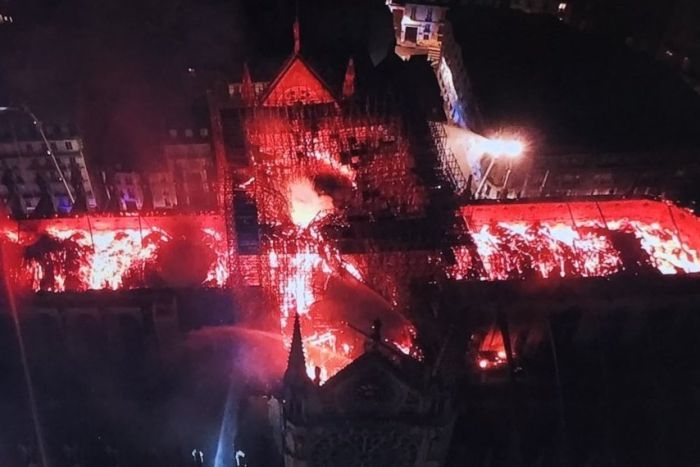 Photo:
An aerial shot reveals the extent of the fire that has burned through the roof and spire of Notre Dame. (Twitter: @AmichaiStein1)
Photo:
An aerial shot reveals the extent of the fire that has burned through the roof and spire of Notre Dame. (Twitter: @AmichaiStein1)
But while Notre Dame was spared from total destruction, two-thirds of the roofing was destroyed.
As the fire spilled in from above, it was feared the interiors of Notre Dame, which have inspired wonder and awe for centuries, would be lost.
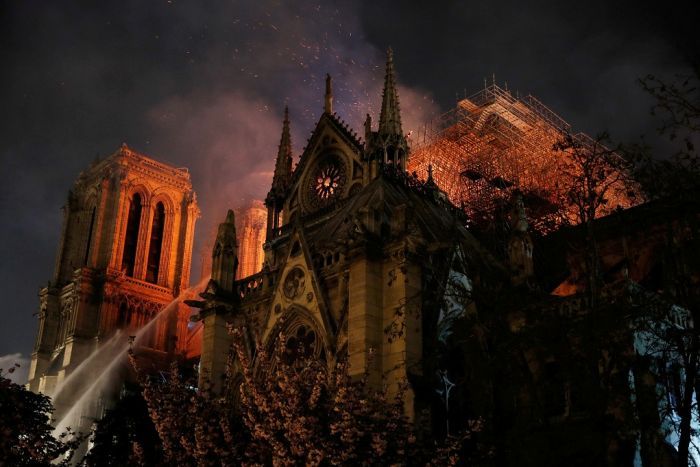 Photo:
Sparks fill the air as Paris Fire brigade members spray water to extinguish flames as the Notre Dame Cathedral burns in Paris, France on April 15, 2019. (Reuters: Philippe Wojazer)
Photo:
Sparks fill the air as Paris Fire brigade members spray water to extinguish flames as the Notre Dame Cathedral burns in Paris, France on April 15, 2019. (Reuters: Philippe Wojazer)
However, inside awaited something of a miracle.
Apart from a hole where the spire had stood, the interior appears relatively untouched.
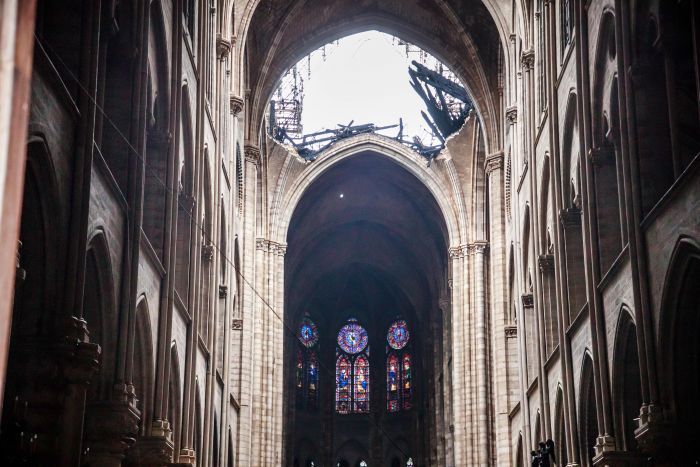 Photo:
The day after the fire, sunlight streams into Notre Dame's interior through a hole in the damaged vault. (Pool via AP: Christophe Petit Tesson)
Photo:
The day after the fire, sunlight streams into Notre Dame's interior through a hole in the damaged vault. (Pool via AP: Christophe Petit Tesson)
High resolution imagery captured by art historians Andrew Tallon and Stephen Murray shows the cathedral's stone vaulting before the blaze.
 Photo:
A panoramic image of the interior of the Notre Dame Cathedral created by Andrew Tallon and Stephen Murray (Andrew Tallon/Stephen Murray: Mapping Gothic France)
Photo:
A panoramic image of the interior of the Notre Dame Cathedral created by Andrew Tallon and Stephen Murray (Andrew Tallon/Stephen Murray: Mapping Gothic France)
 Photo:
The falling spire punched a hole in the vault, but elsewhere the stonework stood up to the test. (AP: Philippe Wojazer)
Photo:
The falling spire punched a hole in the vault, but elsewhere the stonework stood up to the test. (AP: Philippe Wojazer)
Designed in the 12th century using a modern technique for the time, it may have been a factor in keeping the ceiling intact while the roof burned.
Notre Dame's six-part vaults, an early example of the style in Europe, were designed like an arch, allowing for high ceilings — letting more light into the nave — while remaining structurally sound.
"Most of the vaults seem to have survived, which is a testament to how well they were put together in the 12th century," Dr Robert Bork, an architectural historian at the University of Iowa, told the ABC.
Important aspects of the building's interior were also spared.
"All the 18th-century steles, the pietas, frescoes, chapels and the big organ are fine," Notre Dame's heritage director Laurent Prades said.
Mr Prades said the high altar, installed in 1989, was hit and harmed by the cathedral's spire when it came crashing down in the flames.
 Photo:
Most of the relics within Notre Dame cathedral were saved, but not everything can be replaced. (AP: Christophe Petit Tesson)
Photo:
Most of the relics within Notre Dame cathedral were saved, but not everything can be replaced. (AP: Christophe Petit Tesson)
While money to restore the cathedral has been flowing in, it was built using methods of medieval artisanry that may not be perfectly replicated, and some of the wood that burned may be replaced by other materials.
"You might say, 'well it's not actually recreating Notre Dame as it was. But perhaps it can't be recreated as it was'," Professor Peter McPhee, a specialist in French history at the University of Melbourne, told the ABC.
As shocking as it was to witness, in time this episode will become just another fold in the fabric that makes up the grand old dame of Paris — to take its place alongside the stories of saints and martyrs, kings and hunchbacks.
 Photo:
Notre-Dame Cathedral after a massive fire devastated large parts of the gothic structure in Paris, France, April 16, 2019. (Reuters: Benoit Tessier)
Photo:
Notre-Dame Cathedral after a massive fire devastated large parts of the gothic structure in Paris, France, April 16, 2019. (Reuters: Benoit Tessier)
Credits
- Internal Panoramas - Professor Andrew Tallon and Professor Stephen Murray: Mapping Gothic France
- Satellite Imagery - Google Earth/Digital Globe
- Development - Nathan Hoad and Colin Gourlay
- Production - Tim Leslie and Paul Donoughue
- Editor - Cristen Tilley
Topics: fires, disasters-and-accidents, history, architecture, france
First posted



